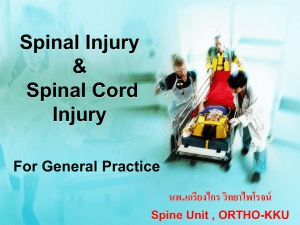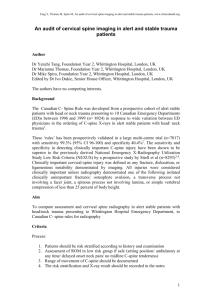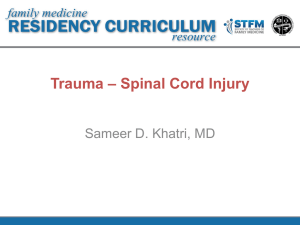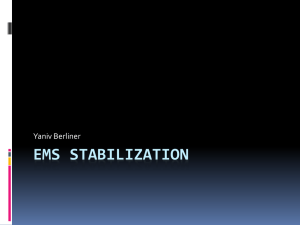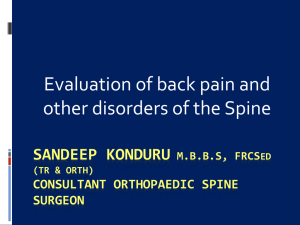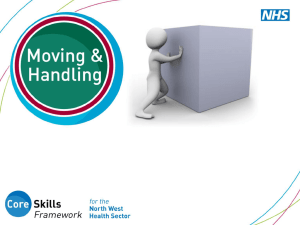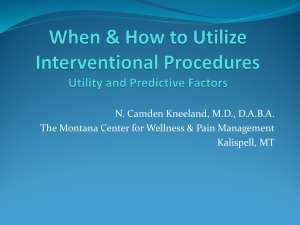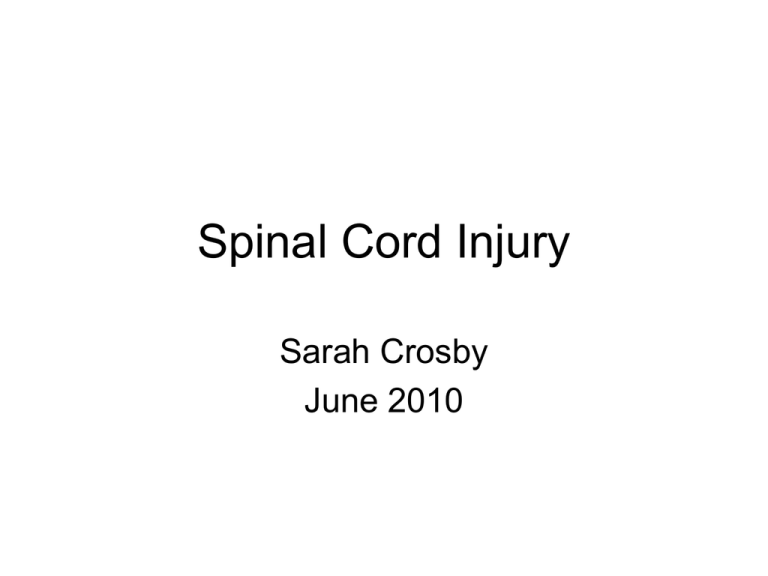
Spinal Cord Injury
Sarah Crosby
June 2010
C-Spine
Epidemiology
• C-spine injuries occur in 2.0-6.6% of blunt trauma patients
• Co-existing head injury increases the incidence of C-spine injury
to 10%
• Injury to the cervical spinal cord in the absence of fracture
occurs in 0.07-0.7% of trauma admissions
• Missed or delayed diagnosis of cervical spine injury occurs in 48%
– Results in 10 x the incidence of secondary neurologic deficit
compared to early diagnosis
– Of the patients with missed or delayed diagnosis most have
decreased GCS, hypotension or critical injuries
– Obtunded patients unable to assist in demonstrating neurology
• Lifetime healthcare and living costs for a quadriplegic patient
$2.4-3.1 million AUD
EAST Guidelines
(Eastern Association for the Surgery of Trauma)
• 1998 guidelines for evaluation of c-spine injury in
trauma patients
• 2009 update
– CT largely replacing plain x-rays
– Clinical clearance remains standard in awake, alert patients
with no neurologic deficit, distracting injury, neck pain or
tenderness
– Cervical collars should be removed ASAP
– Controversy still exists regarding cervical spine clearance in
the obtunded patient
• Who needs imaging
• What imaging
• How to exclude significant ligamentous injury
Removal of Cervical Collars
• As soon as feasible (Level III)
• Early removal is associated with:
– Decreased collar related pressure ulcers
• Skin breakdown 6.8% after 24h
–
–
–
–
Decreased ICP
Fewer ventilator days
Fewer ICU and hospital days
Decreased incidence of delerium and pneumonia
Penetrating Brain Injury
• Immobilisation is not indicated unless
the trajectory suggests direct injury to
the cervical spine
Clinical Clearance of the
C-spine in the awake patient
• In awake, alert trauma patients without neurologic
deficit or distracting injury, who have no neck pain or
tenderness with full range of motion of the cervical
spine, imaging is not necessary and the collar can be
removed (Level II)
• Meta-analysis of clinical clearance of the
asymptomatic C-spine (2010)
–
–
–
–
–
–
GCS 14-15
No posterior cervical tenderness
No neurological deficit
No dangerous mechanism
No distracting Injury
Normal range of motion without pain or neurology
Sensitivity 98.1%
NPV 99.8%
NEXUS Study
Validated 5 Criteria for Low Probability of
C-Spine Injury
(No imaging required if meet all criteria)
1.
2.
3.
4.
5.
No posterior midline C-spine tenderness
No evidence of intoxication
Normal level of alertness
No focal neurologic deficit
No painful distracting injury
Long bone fracture, visceral injury requiring surgical
consultation, large laceration, degloving injury, crush
injury, large burns
Hoffman et al. Validity of a set of clinical criteria to rule out injury to the cervical spine in patients with blunt
trauma. NEJM 2000;343:94-99.
Canadian Cervical Spine Rule Study
1. Are there any high
risk factors present
that require imaging
GCS 15
YES
NO
2. Are there any low
risk factors present to
allow for safe
assessment by using
active range of motion
NO
Image C-Spine
NO
YES
3. Can the patient
actively rotate the
neck 45º left and right
YES
No imaging of Cspine needed
Stiell, I. et al. The Canadian C-spine rule for radiography in alert and stable trauma patients.
JAMA 2001;286:1841-1848
Canadian Cervical Spine Rule Study
1.
High risk factors that
require imaging
–
–
Age ≥65 yo
Dangerous mechanism
of injury
•
•
•
•
•
–
Fall from 1m (5 stairs)
Axial load to the head
(eg. Diving)
MVA- high speed
(>100kph, rollover,
ejection)
Motorised
recreational vehicles
Bicycle collision
Paraesthesia in
extremities
2. Low risk factors that
allow safe assesment of
range of motion
– Sitting position in the
emergency department
or
– Simple rear end MVA
or
– Ambulatory at any one
time or
– Delayed onset of neck
pain
or
– Absence of midline Cspine tenderness
Clinical Clearance of the C-Spine in
the Awake Patient
NEXUS
CCR
Sensitivity 90.7%
Sensitivity 99.4%
Specificity 36.8%
Specificity 45.1%
Radiography Rate 55.9%
Radiography Rate 66.6%
Stiell IG, et al. The Canadian c-spine rule versus the nexus low-risk criteria in patients with trauma.
NEJM 2003;349:2510-2518
Radiographic Examination of
the C-Spine
• Plain C-spine X-Rays
– 3-view (lateral, AP, odontoid)
– Supplemented by swimmers views and CT for
poorly visualised areas
• CT C-Spine
– Occiput to T1 with saggital and coronal
reconstruction
– More time efficient and cost-effective in moderate
and high risk cases
– More accurate
• Sensitivity 98% (vs c-spine x-ray 52%)
Radiographic Examination of
the C-Spine
• Indicated for:
–
–
–
–
Pain or tenderness in the neck
Neurological deficit
Altered mental status
Distracting Injury
• The Primary screening modality is axial CT from the
occiput to T1 with sagittal and coronal
reconstructions (Level II)
• Plain radiographs contribute no additional information
and should not be obtained (Level II)
• If there is neurological deficit attributable to a c-spine
injury an MRI should be obtained
Neck Pain with negative CT in
the neurologically intact patient
3 options (Level III)
1. Continue collar
2. Remove collar after negative MRI (<72h)
3. Remove collar after negative and adequate
flexion extension films
•
•
Picks up c-spine instability in 6.75-8% of normal cspine films
Incidence of isolated ligamentous injury is rare (0.6%
of traumatic c-spine injuries)
C-spine Clearance in the Obtunded Trauma
Patient with a Negative CT C-Spine and no
Gross Neurological Deficit
EAST Recommendations 2009
• Flexion/Extension radiographs should NOT be
performed (Level II)
• The risk/benefit ratio of obtaining an MRI in addition
to CT is not clear (individualise to each institution)
(Level III)
• Options are:
1. Continue cervical collar immobilisation until a clinical
examination can be performed
2. Remove the cervical collar on the basis of CT alone
3. Obtain an MRI and if negative the collar can be safely
removed (Level II)
? MRI in addition to CT?
• Incidence of ligamentous injury with negative
CT c-spine is very low (<5%)
• Incidence of clinically significant injury is even
lower (<1%)
• Expensive
• Difficult in the intubated patient
• Limited availability
• More sensitive for identification of soft tissue
injuries (Gold standard for spinal cord injury)
• Not reliable for identifying bony injury
Albrecht et al.
Evaluation of cervical spine in
intensive care patients following blunt
trauma. World J Surg 2001
150 Patients (150 obtunded)
Retrospective study of blunt trauma ICU patients.
25% of patients with negative x-rays or CT C-spine had
extradural soft tissue or ligamentous injury on MRI
(only 1 required operative stabilisation)
Ghanta et al.
An analysis of Eastern Association for
the Surgery of Trauma Practice
guidelines for cervical spine evaluation
in a series of patients with multiple
imaging techniques. Am Surg. 2002
124 patients (51 obtunded)
Retrospective study of trauma patients.
All had plain C-spine x-ray, CT and MRI.
19% of patients had injuries only evident on MRI
Horn et al.
Cervical magnetic resonance imaging
abnormalities not predictive of cervical
spine instability in traumatically injured
patients J. Neurosurg Spine
314 patients (22 obtunded)
Retrospective study of c-spine MRI patients.
42% of patients with no injury detected on CT or C-ray
had abnormality detected on MRI.
No cervical instability detected on MRI that wasn’t evident
on CT or flexion/extension
Holmes et al.
Variability in computed tomography
and magnetic resonance imaging in
patients with cervical spine injuries.
J Trauma 2002
688 patients
Prospective multicentre study of blunt trauma patients.
MRI superior to CT for detection of cervical spine
ligamentous and cord injuries. CT was superior for
skeletal and facet joint injuries.
SCIWORA
Significant Cord Injury without obvious
radiological abnormality
• Incidence 3-5% (x-ray/CT)
• Higher incidence in paediatric population (34.8%)
– The relatively large size of the head
– inherent skeletal mobility
– cord vulnerable to damage
• Higher incidence above 60 yo
• Posterior vertebral spurs due to spondylosis
• Ligamentum flavum bulging due to loss of disc height
– Risk of central cord syndrome after hyperextension injury
Thoracolumbar Spine Trauma
• 4.4% of trauma patients have TLS
fracture
– 19-50% of these fractures are associated
with spinal cord damage
– Higher incidence of neurologic deficit when
fracture identification was delayed (10.5%
vs 1.4%)
EAST Recommendations (2007)
• Level II Guidelines
– Trauma patients should be examined by a
qualified attending physician
• Trauma surgeons, emergency physicians or
spine surgeons (neurosurgery or orthopaedics)
– Trauma patients who are awake, without
any evidence of intoxication, with normal
mental status, neurologic and physical
examinations may be cleared clinically
EAST Recommendations (2007)
• Radiographic Examination is required for:
– High energy mechanism of injury
•
•
•
•
•
•
–
–
–
–
Falls from >10 feet
MVA/MBA crash with or without ejection
Pedestrians struck
Assault, Sport or Crush injury
Bicycle injury
Concomitant cervical spine fracture
Altered mental status, intoxication
Distracting injuries
Neurologic deficits
Spine pain or tenderness on palpation
Mode of Imaging of TLS
• Multidetector CT with axial reconstruction is superior
to plain films for screening of TLS for bony injury (II)
• CT scout films can be used for spine assessment (II)
• CT scan may be associated with less overall
radiation exposure than plain films (III)
• Plain films are adequate for the examination of the
TLS if the patient does not require CT scan for any
other reason (III) (Not if they have a major trauma
mechanism)
• MRI is indicated for patients with neurologic deficits,
abnormal CT scans or clinical suspicion despite
normal radiographic evaluation suggesting an
unstable injury (III)
– Early decompression of traumatic lesions improves outcome
Plain Film vs CT of TLS
• Ballock et al. (1992)
– plain radiography of the thoracolumbar spine would have
missed 25% of fractures
• Gestring et al. (2002)- CT protocol for examining TLS
– Anterior, posterior and lateral scout films and axial images
– 100% sensitivity and specificity
• Hauser et al. (2003)-prospective study 222 patients
– Plain radiography of the TL spine vs Helical CT (5mm
images)
– CT scan accuracy 99% vs plain radiographs 87%
– CT could also differentiate acute vs old #
• Sheridan et al. (2003)
– Reformatted helical T (2.5mm images) vs plain x-ray
– Sensitivity for Thoracic #- CT 97% vs x-ray 62%
– Sensitivity for Lumbar #- CT 95% vs x-ray 86%
“Clearing” the Spine
• The ultimate evaluation of all radiographic
studies is the responsibility of the attending
radiologist.
• Other persons qualified to interpret TLS
radiographs
–
–
–
–
Trauma surgeon
Emergency medicine physician
Neurosurgeons
Orthopaedic spine surgeons
• These may clear the spine after interpretation
of the images and clinical evaluation of the
patient
Obtunded Patient
• No level I evidence
• Level II
– Multidetector CT with axial reconstruction is
superior to plain films for screening of the TLS for
bony injury
• Level III
– The obtunded patient (intoxicated or head injury)
presenting to a centre without CT scan capability
should be transferred to the nearest available
trauma centre
Primary Management
A - Airway control with C-spine immobilisation
B- Avoid hypoxaemia- will further worson the prognosis
of an injured spinal cord
- Injury above C5 will cause respiratory insufficiency
- 50% of C3 tetraplegics need permanent ventilation
C- Need to minimise secondary ischaemic injury to the
cord - Aim MAP > 100mmHg
- SCI above C6 associated with loss of cardiac
sympathetic supply leading to hypotension &
bradycardia
- Loss of sympathetic vasoconstriction leads to
vasodilation & venodilation
- relative hypovolaemia needing plasma volume
expansion and vasoconstrictors
Secondary Survey of Spine
• Assessment of the cervical soft tissue for swelling
• Log roll and palpation of the spinous processes of the entire
spinal column
• Neuro exam
– Motor, sensory and reflexes
– Perianal sensation, rectal sphincter tone and sacral reflexes
– Absence of the bulbocavernosus reflex indicates spinal shock
• Signs of SCI in unconscious patient
–
–
–
–
–
–
–
–
Response to pain above but not below a level
Flaccid areflexia in arms/legs
Elbow flexion with the inability to extend (cervical SCI)
Paradoxical breathing
Inappropriate vasodilation
Unexplained bradycardia, hypotension
Priapism
Loss of anal tone and reflexes
Spinal Cord Injury
• Complete SCI
– muscle paralysis
– somatic and visceral sensory loss below a discrete segment
• Spinal shock
– Additional features of
•
•
•
•
•
Muscle flaccidity
Absence of tendon reflexes
Vaso and venodilation
Loss of bladder function
Paralytic ileus
– Due to temporary loss of somatic and autonomic reflex activity
below the neurological level of the injury
– Lasts 1-3 weeks
Early Surgical Management of
Spine Injuries
• Cervical Spine Injuries
– Acute stabilisation with a halo ring allows further diagnostic
evaluation and treatment of other injuries without further neurologic
deterioration
• Thoracolumbar Spine Fractures
– McLain & Benson compared urgent spinal stabilisation (+/decompression within 24h) vs early treatment (24-72h)
– No statistical difference in outcomes
– the urgent group had a non-statistical better neurological recovery
• Kerwin et al.
– Early stabilisation (<3 days) shortens ICU and hospital LOS but
increased number of perioperative deaths and pneumonia
• Spinal cord compression with neurologic involvement as a result
of spinal malalignment should be remedied as soon as possible
(esp facet subluxations or dislocation)
Medical Management of Acute
Spinal Cord Injury
• Primary Injury
– Primary cell death that occurs at time of injury
– Due to direct mechanical forces causing structural disruption
of neuronal, glial and vascular structures
• Secondary Injury (days to weeks) (10% of injury)
– Variety of chemical pathways including hypoxia, ischaemia,
ionic shifts, lipid peroxidation, free radical production,
excitotoxicity, eicosanoid production, protease activation,
prostaglandin production and apoptosis
– Medical strategies for treatment of SCI are directed at
minimising the degree of secondary injury
Spinal Cord Perfusion
Pressure
• Most important medical management of
spinal cord injury is to maintain arterial
oxygenation and blood pressure support
– Class III evidence to suggest optimising
spinal cord perfusion improves clinical
outcome
– Maintain SBP between 85-90mmHg for first
week
Steroids
• NASCIS II (1992)
– Prospective randomised double blind controlled multicentre
trial (487 patients)
– High dose Methylprednisolone vs Naloxone Vs Placebo
given within 24h of SCI
– No difference in neurologic outcome between the 3 groups
– Post hoc analysis showed patients treated with Methylpred
within 8h had statistically significant improvement in motor
and sensory scores at 6 months, but only improved motor
scores at 1 year
– Steroid group had increased pulmonary emboli, wound
infections (non-significant), myopathy
• NASCIS III
– 48h Methylprednisolone was associated with severe
pneumonia, severe sepsis.
GM-1 Ganglioside
• Compound normally found in cell membranes
of CNS tissue in mammals
• Antiexcitotoxic activity
• Promotes neuritic sprouting
• Potentiates the effects of nerve growth factor
• Prevents apoptosis
• Initial promising results, not reproduced in
long term follow-up
• Not used in clinical practice
Future Directives
• Stem cell transplantation
• Electric Field gradients to influence
nerve growth after injury
• Neuroprotective strategies
– Monoclonal antibodies
– Minocycline
– Rho inhibitor
– Macrophage injection
References
Ackland, H. et al. Magnetic Resonance Imaging for clearing the cervical spine in unconscious intensive care trauma
patients. J. Trauma 2006;60:668-673
Practice Management Guidelines for identification of cervical spine injuries following trauma- update from the Eastern
Association for the Surgery of Trauma Practice Managament Guidelines Committee. J.Como, J.Diaz, M Dunham
J Diaz et al. Practice Management Guidelines for the Screening of Thoracolumbar Spine Fracture. J Trauma 2007;63:709718
Harris, M. et al. The initial assessment and management of the Multiple-Trauma patient with an associated spine injury.
Spine 2006;31:S9-S15
Hurlbert, R. Strategies of Medical Intervention in the Management of Acute Spinal Cord Injury. Spine 2006;31:S16-S21
Rechtine G. Nonoperative Management and Treatment of Spinal Injuries. Spine 2006;31:S22-S27
Stiell IG, et al. The Canadian c-spine rule versus the nexus low-risk criteria in patients with trauma. NEJM 2003;349:25102518
Stiell, I. et al. The Canadian C-spine rule for radiography in alert and stable trauma patients. JAMA 2001;286:1841-1848
Hoffman et al. Validity of a set of clinical criteria to rule out injury to the cervical spine in patients with blunt trauma. NEJM
2000;343:94-99.
Richards, P. Cervical Spine Clearance: a review. Injury, Int. J. Care Injured. 2005;36:248-269
Ed Bersten, A. Soni, N. Oh’s Intensive Care Manual, 5th Edition.2003.
Ed Wilson W.et al Trauma- Emergency Resuscitation, Perioperative Anaesthesia, Surgical Management. Vol 1. 2007

